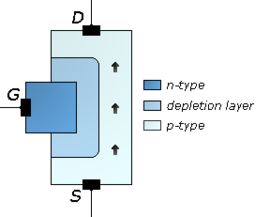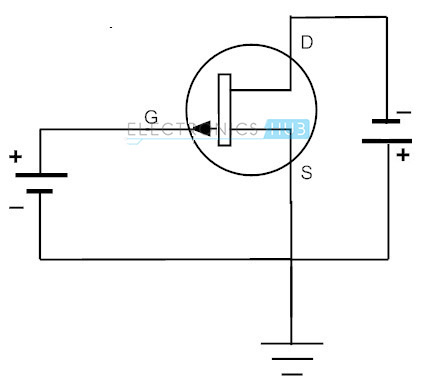Ciircuits, Diagrams & Symbols Includes:
Circuit symbols overviewResistorsCapacitorsInductors, coils, chokes & transformersDiodesBipolar transistorsField effect transistorsWires, switches & connectorsAnalogue & functional circuit blocksLogic
Field effect transistors, FETs come in a large variety of different types. Each type of FET has its own circuit symbol, so it helps to understand the different types of FET and their circuit symbols to enable the circuits to be read accurately.
P channel JFET consists of a P-type bar, at two sides of which n-type layers are doped. The gate terminal is formed by joining the ohmic contacts at both sides. Like in an N channel JFET, the source and drain terminals are taken from the other two sides of the bar. JFET JFETs are available at Mouser Electronics from industry leading manufacturers. Mouser is an authorized distributor for many JFET manufacturers including Fairchild, ON Semiconductor, Vishay, & more. Please view our large selection of JFETs below.
Junction FETs or JFETs were the first type of FET and these have a distinctive symbol showing the diode junction. Insulated gate FETs, including MOSFETs have circuit symbols that indicate the insulation on the gate.
Note that you can make the p-channel JFET characteristic curves look like the common n-channel JFET curves just by rotating the pJFET plot by 180°. In swapping n-channel for p-channel so nJFET pJFET, we've reversed the direction of current flows (so currents are negative - flowing out of the drain in a pJFET) and the required supply voltage.
Obviously dual gate FETs have two gates and both need to be incorporated into the circuit symbol.
| FET Circuit Symbols | |
|---|---|
| FET Type | Circuit Symbol |
| J-FET N channel | |
| J-FET P channel | |
| Basic enhancemment insulated gate FET (MOSFET) N channel | |
| Basic enhancemment insulated gate FET (MOSFET) P channel | |
| Basic enhancemment insulated gate FET (MOSFET) N channel no bulk semiconductor | |
| Basic enhancemment insulated gate FET (MOSFET) P channel no bulk semiconductor | |
| Basic depletion insulated gate FET N channel | |
| Basic depletion insulated gate FET P channel | |
P Fet Vs N Fet
Note: The circuit symbols for FETs are marked with D, G and S for drain, gate and source. These letters are not normally included in circuit diagrams, but they are included here for clarity and explanation.

More Circuits & Circuit Design:
Op Amp basicsOp Amp circuitsPower supply circuitsTransistor designTransistor DarlingtonTransistor circuitsFET circuitsCircuit symbols
Return to Circuit Design menu . . .
A P-Channel JFET is a JFET whose channel is composed primarily of holes as the charge carrier. This means that when the transistor is turned on, it is primarily the movement of holes which constitutesthe current flow.
This is in contrast to N-Channel JFETs, whose channel is composed primarily of electrons, which constitute the current flow.

A P-Channel JFET is composed of a gate, a source and a drain terminal.
It is made with an p-type silicon channel that contains 2 n-type silicon terminals placed on either side. The gate lead is connected to the N-type terminals, while the drain and source leads are connected to either ends of the P-type channel.
When no voltage is applied to the gate of a P-Channel JFET, current (holes) flows freely through the central P-channel. This is why JFETs are referred to as 'normally on' devices. Even without any voltage, they conduct current across from source to drain.
How a P-Channel JFET Works
This is a typical diagram you would see of voltage biasing of a P-channel JFET. This diagram also servesto show you all the parts of a P-channel JFET.

How to Turn on a P-Channel JFET
Jfet P-channel Switch

To turn on a P-channel JFET, apply a positive voltage VS to the source terminal of the transistor with no voltage applied to the gate terminal of thetransistor. This will allow a current to flow through the drain-source channel. If the gate voltage, VG, is 0V, the drain current is at its largest value for safe operation, and the JFET is in the ON active region.
So with a sufficient positive voltage to the source terminal of the transistor and no voltage (0V) applied to the base, the P-channel JFET is in maximum operation and has the largest current flow across the source-drain terminal.
How to Turn Off a P-Channel JFET
To turn off a P-channel JFET, there are 2 steps you can take. You can either cut off the bias positive voltage, VS, that powers the source terminal. Or you can apply a positive voltage to the gate. When a positivevoltage is applied to the gate, the source-drain current is reduced. As the gate voltage, VG, becomes more positive, the current lessens and lessens until it completes reaches cutoff, which is when then JFET is in the Off condition and no current conducts across from source to drain. This stops all drain-source current flow.
Characteristics Curve of a P-Channel JFET
The characteristics curve of a P Channel JFET transistor shown below is the the graph of the drain current, ID versusthe gate-source voltage, VGS.
This curve represents the transconductance, or simply the gain, of the transistor.
The transconductance of a transistor really means the gain of the transistor.
So this transconductance characteristics below shows the gain of the transistor, how much current the transistor outputs based on the voltage input into the gate terminal. Remember that gain is the the output over the input. The input is how much voltage is fed to the gate terminal. The output is how much current the transistor outputs.
You can see based on this P channel JFET transconductance curve that as the positive voltage to the gate increases, the gain decreases. You can see that the gain, the current ID output by the transistor, is highest when the voltage fed to the gate terminal is 0V. As we increase this voltage, again, as stated, the gain decreases.
This transconductance curve is important because it shows the operation of a P channel JFET.
P Fet Symbol
You can also see that the transconductance curve, as for all semiconductor devices, is nonlinear, for most of the curve,meaning changes to VGSdo not directly (linearly) increase or decrease drain current, ID, even though this is a lesser issue.
The big point is that, a P-Channel JFET turns on by having a positive voltage applied to the source terminal of the transistor and ideally no voltage applied to the gate terminal. The transistor circuitshuts off by taking in a positive gate voltage, VGS, above about +4V or so. The transistor is in its fully conductive state and is in maximum operation when the voltage at the gate terminal is 0V. As we increase the amount of positive voltage the gate terminal receives, the transistor becomes less conductive. Once the positive voltage reachesa certain threshold, the P channel JFET circuit stops conducting altogether across the source-drain terminal.
Regions of the Characteristics Curve
The Regions that make this characteristic curve are the following:
Cutoff Region- This is the region where the JFET transistor is off, meaning no drain current, ID flows through the source-drain region.
Ohmic Region- This is the region where the JFET transistor begins to show some resistance to the drain current ID that is beginning to flow through the source-drain region. This is the only region in the curvewhere the response is linear.
Saturation Region- This is the region where the JFET transistor is fully operational and maximum current is flowing. During this region, the JFET is On and active.
Jfet Switch Circuit
Breakdown Region- This is the region where the voltage that is supplied to the source terminal of the transistor exceeds the necessary maximum. At this point, the JFET loses its ability to resist current because too much voltage is applied across its source-drain terminals. The transistor breaks down and current flowsfrom source to drain.
If you really want to make sense of all the technical details of the graph above, you have to really that a P-channel normally receives positive voltage to the source terminal of the JFET. So the source terminal receives positive voltage and the drain terminal is normally grounded. So the source terminal is positive relative to the drain terminal. Notice that the voltage on the horizontal of the graph represents the voltage, VDS. VDS is the voltage across the drain and the source, in that order. Since we, again, feed positive voltage to the source terminal and ground the drain terminal, the drain terminal is negative with respect to the source terminal. This is why you see negative voltages for VDS. A negative voltage for VDS just means that we're feeding positive voltage to the source terminal. So if you think of it that way, it makes a lot of sense. If you look all the way to the left of the curve at VDS being around 0V, no drain current can flow because the source terminal needs positive voltage. So if we increase positive voltage to the source terminal which means we're making the drain terminal more negative, we increase the output drain current. About +10V to the source is the midpoint of the graph (which is -10V VDS). And as we go above about +20V or so the source terminal, we reach the transistor's breakdown point.
So this should help to understand a P Channel JFET characteristics curve better and thus a P channel JFET as a whole.
Related Resources
How to Build a P Channel JFET Switch Circuit
N-Channel JFET Basics
N-Channel MOSFET Basics
P-Channel MOSFET Basics
